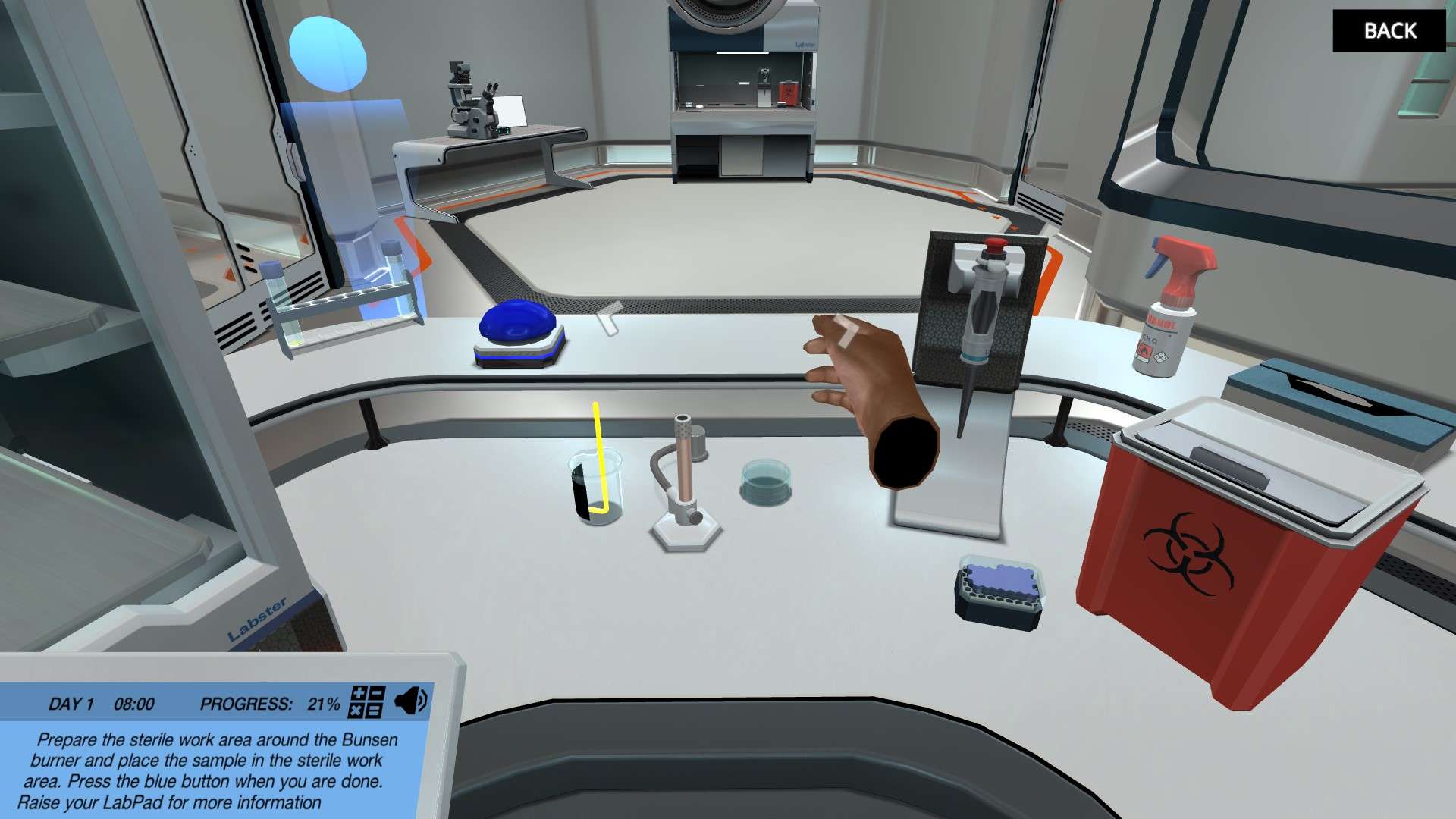Heading 1
Heading 2
Heading 3
Heading 4
Heading 5
Heading 6
Lorem ipsum dolor sit amet, consectetur adipiscing elit, sed do eiusmod tempor incididunt ut labore et dolore magna aliqua. Ut enim ad minim veniam, quis nostrud exercitation ullamco laboris nisi ut aliquip ex ea commodo consequat. Duis aute irure dolor in reprehenderit in voluptate velit esse cillum dolore eu fugiat nulla pariatur.
Block quote
Ordered list
- Item 1
- Item 2
- Item 3
Unordered list
- Item A
- Item B
- Item C
Bold text
Emphasis
Superscript
Subscript
About This Simulation
Help a microbiologist prepare a pure culture that can be used to identify a microbe causing an infection! Use good aseptic technique to avoid contamination of the sample, ensure your own safety, and avoid surprise fires in the lab.
Learning Objectives
- Understand the principles of aseptic technique for the prevention of infection and contamination
- Create and maintain a sterile work area
- Use sterile equipment and consumables correctly
- State potential sources of microbial contamination
- Assess whether a sample was contaminated
About This Simulation
Lab Techniques
- Culturing
- Aseptic Technique
Related Standards
- Alignment pending
- Alignment pending
- Alignment pending
Learn More About This Simulation
This simulation, along with “Fermentation: Optimize bio-ethanol production,” was adapted from learning objectives in the original “Fermentation” simulation. For more information on this topic, see Labster's Microbiology simulations.
A patient sample has arrived in the microbiology lab. Will you be able to culture it using good aseptic technique? Learn about aseptic technique and what you should pay attention to when preparing a sterile work area, sterilizing equipment and reagents, and decontaminating the work area after you finish your experiment.
Preparing a sterile field
You will start off by preparing the sterile work area. Use your own microbiology knowledge, the tooltips, and theory pages to ensure you are using good aseptic technique. Don’t worry if you make a mistake and your work area is not quite sterile. In the virtual lab, Dr. One can guide you to repeat some steps without losing several hours like you would in the physical lab.
Culturing and cleaning up
Next, you will culture your sample and the appropriate control using sterile equipment and reagents. Once you have placed your samples in the incubator: it’s clean up time! Dr. One will again guide you if you accidentally contaminated one of the samples or accidentally set the lab on fire.
Analyzing your results
After the incubation, check your samples to see if you have used correct aseptic technique throughout the experiment. Will you be able to create a pure culture that the microbiologist can use to identify an unknown microbe?
RELATED SIMULATIONS
Fermentation: Optimize bio-ethanol production
Fermentation
For Science Programs Providing a Learning Advantage
Boost STEM Pass Rates
Boost Learning with Fun
75% of students show high engagement and improved grades with Labster
Discover Simulations That Match Your Syllabus
Easily bolster your learning objectives with relevant, interactive content
Place Students in the Shoes of Real Scientists
Practice a lab procedure or visualize theory through narrative-driven scenarios


FAQs
Find answers to frequently asked questions.
Heading 1
Heading 2
Heading 3
Heading 4
Heading 5
Heading 6
Lorem ipsum dolor sit amet, consectetur adipiscing elit, sed do eiusmod tempor incididunt ut labore et dolore magna aliqua. Ut enim ad minim veniam, quis nostrud exercitation ullamco laboris nisi ut aliquip ex ea commodo consequat. Duis aute irure dolor in reprehenderit in voluptate velit esse cillum dolore eu fugiat nulla pariatur.
Block quote
Ordered list
- Item 1
- Item 2
- Item 3
Unordered list
- Item A
- Item B
- Item C
Bold text
Emphasis
Superscript
Subscript
A Labster virtual lab is an interactive, multimedia assignment that students access right from their computers. Many Labster virtual labs prepare students for success in college by introducing foundational knowledge using multimedia visualizations that make it easier to understand complex concepts. Other Labster virtual labs prepare learners for careers in STEM labs by giving them realistic practice on lab techniques and procedures.
Labster’s virtual lab simulations are created by scientists and designed to maximize engagement and interactivity. Unlike watching a video or reading a textbook, Labster virtual labs are interactive. To make progress, students must think critically and solve a real-world problem. We believe that learning by doing makes STEM stick.
Yes, Labster is compatible with all major LMS (Learning Management Systems) including Blackboard, Canvas, D2L, Moodle, and many others. Students can access Labster like any other assignment. If your institution does not choose an LMS integration, students will log into Labster’s Course Manager once they have an account created. Your institution will decide which is the best access method.
Labster is available for purchase by instructors, faculty, and administrators at education institutions. Purchasing our starter package, Labster Explorer, can be done using a credit card if you are located in the USA, Canada, or Mexico. If you are outside of North America or are choosing a higher plan, please speak with a Labster sales representative. Compare plans.
Labster supports a wide range of STEM courses at the high school, college, and university level across fields in biology, chemistry, physics, and health sciences. You can identify topics for your courses by searching our Content Catalog.















